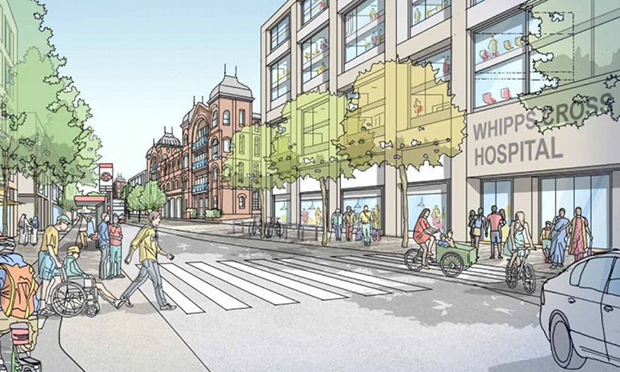Campaigners call for close scrutiny of plans to revamp ‘severely overstretched’ Whipps Cross hospital

Local councillors are being urged by campaigners to look closely at plans for the redevelopment of Whipps Cross hospital amid warnings about bed capacity.
The Waltham Forest hospital, which serves residents across north-east London, was given the go-ahead by the government last September to build a brand new site.
Councillors sitting on an influential cross-borough scrutiny committee will next week consider the proposal, alongside campaigners’ warnings about “risks to residents” posed by the potential reduction in bed numbers.
Norma Dudley of Save Our NHS wrote: “Pre-Covid, Whipps was running at 98 to 99 per cent bed occupancy, sometimes with no free beds. National Institute for Health and Care Excellence (NICE) guidance states that once bed occupancy goes above 90 per cent, infections, re-admissions and increased mortality are likely. Whipps is a severely overstretched hospital.
“Barts Trust are proposing 51 fewer beds in the redeveloped hospital than we have at present, and 109 fewer than needed, if there’s no improvement to community services. Barts proposes that the new hospital could be a centre of excellence for the care of older people across much of north-east London – with fewer beds.
“Last year the head of NHS England Sir Simon Stevens said bed closures had gone too far and that many areas will need more beds, despite plans to expand community services.”
According to Barts’ proposals, more investment is required for a new Whipps Cross due to the fast growing population of north-east London, with the NHS expecting the hospital’s catchment area to grow by over 10 per cent over the next 10 years, and the number of older people to increase by a quarter.
Part of the reasoning to reduce bed capacity is based on plans for improved care and support outside of hospital, with corresponding predictions made by Barts that more people from the area would avoid making trips to A&E as a result of proposed increases in specialist support, community care and home visits, as well as more phone and video appointments and people self-monitoring through digital aids.
Barts’ plans envision fewer people reaching the stage where they need to be hospitalised, with safe discharges able to be enacted more quickly for those that are, more same-day treatments to replace admissions, and plans to almost double the capacity for diagnostic testing.
The Trust anticipates that the overall number of days that patients spend in a hospital bed could fall by 10 per cent over the next 10 years, with plans for Whipps Cross to host between 471 and 643 beds, with a current assumption of 525.
Barts’ plans add: “The precise number of beds in use at any hospital changes daily, depending on the numbers of patients, the type of care required and safe staffing needs. The average number of beds open in 2018/19 – our baseline for the modelling work – was 576.
“However, our task now is to continue to review and refine our assumptions during the next phase of the work. This means considering the long-term impact of the Covid pandemic on the way in which we deliver care and we expect that those assumptions could continue to change as we do this.
“That work will include developing enabling strategies on key areas such as workforce and digital transformation. Critically, as an extra safeguard, and in response to clear feedback from our communities, we will retain the flexibility to expand our capacity if that is required, both in the way we design the hospital (for example so we can scale up critical care rapidly if we need to) and in the way we retain some land for other NHS facilities on the wider site.”
The best case scenario held by the Trust is that construction work could start in autumn of 2022, with a new hospital potentially completed by autumn of 2026.
According to submissions to the Inner North East London Joint Health Overview & Scrutiny committee, the current condition of the estate leads to “increased safety risks” for patients, with services “sprawled out” over the site, meaning staff and patients have to travel between areas that ought to be close to one another.
Barts has pledged that the new Whipps Cross will deliver “the same core services as today” for north-east London, including A&E, maternity, children’s and a range of surgeries.
Barts chief executive Alwen Williams said: “This redevelopment symbolises hope and the glimpse of a brighter future on the horizon. As chief executive of the Barts Health group of hospitals – and as a local resident – I know how much this means to our staff and to local people.
“Working with them – and alongside our NHS and local government partners – and building on the incredible spirit of collaboration seen recently, we are absolutely determined to get this right to secure the future for generations to come.”
